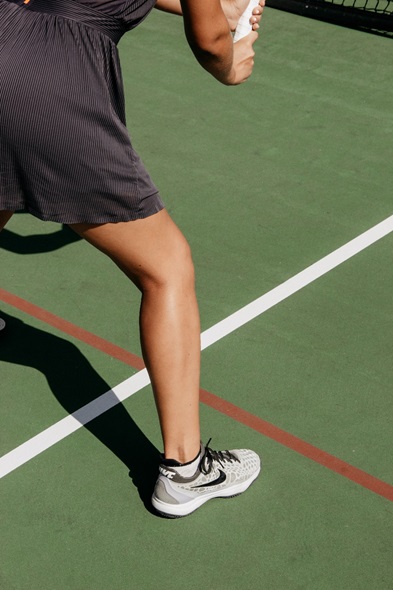Can You Play Tennis in Running Shoes?

Almost everyone has a good pair of running shoes. A pair that has been broken in and feel extremely comfortable around their feet. It’s easy to see such a pair as your trusty companion in anything athletic, and perhaps so far they have held up, but why is there a whole market dedicated to selling tennis shoes if running shoes seem to get the job done? Maybe you want to get into playing tennis, but you don’t want to shell out all those extra dollars for a pair of Barricades. Won’t your trusty pair of Nikes or Reeboks be sufficient?
If you’ve been asking yourself these questions, then hang in, because we’re about to go through all the answers. There’s a lot to know when it comes to the proper footwear or equipment for sports.
It’s All About the Motion
It’s easy to dismiss shoes as mere coverings for your feet. Because a lot of us focus our equipment like a quality tennis racquet. Sure, there are so many different kinds of shoes, but do they differ that extensively? Obviously, you can’t run a 100m sprint in dress shoes, but how different can two types of athletic shoes be when put side-by-side?
The answer is very different. A lot of thought goes into the construction of shoes, and the intended purpose of the footwear influences how the shoe is built. Think about the act of running. You’re going in one direction, and the majority of the stress on the shoe is basically one axis – the forward axis. You’re most likely to be running continuously, with very little, if any, intermittent braking. Running shoes are constructed precisely with the dynamic of the activity in mind. They provide support to the feet and its arches, they act as a shock absorber between the foot and the surface, and provide traction primarily in the forward direction.
The movement we go through when playing tennis is a world apart, however. You’ll be doing a lot of running in a game of tennis, but the dynamic is entirely different. Forward motion is present, though experienced only in short bursts at a time. There is much more lateral motion with the side-stepping that occurs, and all this motion comes interrupted with sudden stops. Tennis shoes are constructed to give you the most functionality on the court with this variety of movement in mind and to keep you safe and uninjured. This is important if you play a lot of matches, practice with a partner, or practice with a tennis ball machine. A pair of tennis shoes will give you suitable traction and support in lateral movement in addition to forward motion. Running shoes definitely can’t make that claim as confidently.
The Construction of a Shoe
From the last section, it’s easy to understand that a running shoe is built for running, and consequently constructed to augment functionality and provide safety and support during activity. The actual construction involves a lighter build in general, as less weight is a clear advantage when it comes to track events. There’s an impact between the foot and the pavement almost every second during a run or a sprint, and running shoes tend to be very generous when it comes to padding as a result. That force needs to be dissipated gently or the strain on the foot will be immense, even after a short run. This can be observed in the thicker padding in the sole at the heels and toes of running shoes. This to provide support for the parts of the feet that bear the most stress during a run. Due to the continuous and almost exclusive forward-directed motion during a run, there is more support for the sides of the feet. Of course, while more support and padding at the sides is a good thing, it limits motion laterally.
Despite the outward appearance not seeming that drastically different, the way a tennis shoe differs, particularly in the sole, is significant. Swingitbig says that the sole on a typical pair of tennis shoes and pickleball footwear is thinner, which brings the foot closer to the ground, and this boosts stability. A tennis shoe has to be able to keep up with the wide range of motion the feet undergo as you strive to return each ball served towards you. While a lightweight shoe would be greatly appreciated in a match, sacrificing weight usually translates to sacrificing support in one way or the other. Tennis shoes tend to be somewhat heavier than running shoes as a result of this because the soles are denser and stiffer than those of running shoes, though maintaining a degree of flexibility. The side padding on a pair of tennis shoes is not as high as on a pair of running shoes so as to ease lateral movement.
A lot goes into the process of making a pair of shoes, and even the differences between categories that seem closely related are vast.
So… Can You Play Tennis in Running Shoes?
Well, to answer the question posed straight from the start of this article, the answer is yes. Should you though? That’s a bit less straightforward to answer.
A lot of people find running shoes perfectly suitable for playing tennis, and that’s fine, but chances are that they play relatively tame matches. Running shoes simply aren’t built to handle the extreme motions that occur in an intense game of tennis, and if you have been getting away with it uninjured so far, you might want to count your blessings and switch to a good pair of tennis shoes. Not only will you be protecting yourself from injury (nobody likes a rolled ankle!), you’ll probably find that your game is significantly improved.
However, if you see tennis as just a gentle pastime and you don’t go to sleep at night with dreams of turning pro, you might not need a pair of tennis shoes. If all you do is hit the ball back and forth with a pal, and lateral movement is kept to a minimum, your Adidas sneakers might be all you need, to be honest. Ultimately, comfort is key and there is no rulebook to these things. But having absorbed all the knowledge in this article, you now know exactly what risks there are when playing with inappropriate footwear.











